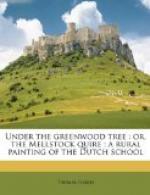His visitors now came and stood on the outside of his window, sometimes leaning against the sill, sometimes moving a pace or two backwards and forwards in front of it. They talked with deliberate gesticulations to Mr. Penny, enthroned in the shadow of the interior.
“I do like a man to stick to men who be in the same line o’ life—o’ Sundays, anyway—that I do so.”
“’Tis like all the doings of folk who don’t know what a day’s work is, that’s what I say.”
“My belief is the man’s not to blame; ’tis she—she’s the bitter weed!”
“No, not altogether. He’s a poor gawk-hammer. Look at his sermon yesterday.”
“His sermon was well enough, a very good guessable sermon, only he couldn’t put it into words and speak it. That’s all was the matter wi’ the sermon. He hadn’t been able to get it past his pen.”
“Well—ay, the sermon might have been good; for, ’tis true, the sermon of Old Eccl’iastes himself lay in Eccl’iastes’s ink-bottle afore he got it out.”
Mr. Penny, being in the act of drawing the last stitch tight, could afford time to look up and throw in a word at this point.
“He’s no spouter—that must be said, ’a b’lieve.”
“’Tis a terrible muddle sometimes with the man, as far as spout do go,” said Spinks.
“Well, we’ll say nothing about that,” the tranter answered; “for I don’t believe ‘twill make a penneth o’ difference to we poor martels here or hereafter whether his sermons be good or bad, my sonnies.”
Mr. Penny made another hole with his awl, pushed in the thread, and looked up and spoke again at the extension of arms.
“’Tis his goings-on, souls, that’s what it is.” He clenched his features for an Herculean addition to the ordinary pull, and continued, “The first thing he done when he came here was to be hot and strong about church business.”
“True,” said Spinks; “that was the very first thing he done.”
Mr. Penny, having now been offered the ear of the assembly, accepted it, ceased stitching, swallowed an unimportant quantity of air as if it were a pill, and continued:
“The next thing he do do is to think about altering the church, until he found ‘twould be a matter o’ cost and what not, and then not to think no more about it.”
“True: that was the next thing he done.”
“And the next thing was to tell the young chaps that they were not on no account to put their hats in the christening font during service.”
“True.”
“And then ’twas this, and then ’twas that, and now ’tis—”
Words were not forcible enough to conclude the sentence, and Mr. Penny gave a huge pull to signify the concluding word.
“Now ’tis to turn us out of the quire neck and crop,” said the tranter after an interval of half a minute, not by way of explaining the pause and pull, which had been quite understood, but as a means of keeping the subject well before the meeting.




